From time to time you may find some of your hamster’s fur around your home, you may wonder whether that’s normal or is there something wrong with your hamster.
Do hamsters shed their fur? Hamsters shed, or rather molt, usually in the spring and fall time. While this is perfectly normal, if your hamster happens to lose a lot of its fur it can indicate a health issue.
In this article, we will explain why hamsters shed, how much they shed, and what you can do to keep your hamster’s fur in the best possible shape.
Get Your Own Hamster Owners Guide!
Table of Contents
Why Do Hamsters Shed?
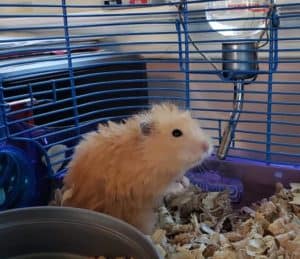
All hamster breeds shed or molt, regularly, but breeds with longer fur will certainly shed a bit more.
For example, Russian and Syrian hamsters will shed more than Roborovski or Chinese hamsters.
This process peaks during spring and fall. The reason for this tendency lies in temperature changes and hamsters shed to acclimate to these changes. Like many other furred animals, hamsters shed their old coat so they can grow new ones.
READ MORE: Are Hamsters Color Blind?
In addition to regular seasonal molting, hamsters can shed during extreme temperature changes or if the weather becomes too hot for longer time periods.
During the shedding periods, it is normal for hamsters’ fur to become thin or even become patchy, with both thick and thin fur areas. In most cases, hamsters will regrow their coats after a few weeks of shedding.
Seasonal shedding is not a reason for the concert, nor can you do anything to stop it. However, there are also other things that lead to fur loss in hamsters.
READ MORE: Why Hamsters Make Good Pets
Other Reasons Why Hamsters Might Lose Hair
Hair loss in hamsters can happen for many reasons, not just due to normal seasonal shedding. The medical term for unnatural hair loss or shedding is alopecia.
Excessive Rubbing

Excessive rubbing on cage feeders, toys, or the cage itself, as well as excessive burrowing, can lead to hair loss around the face.
The friction caused by excessive rubbing is the reason behind hair loss.
Overcrowding
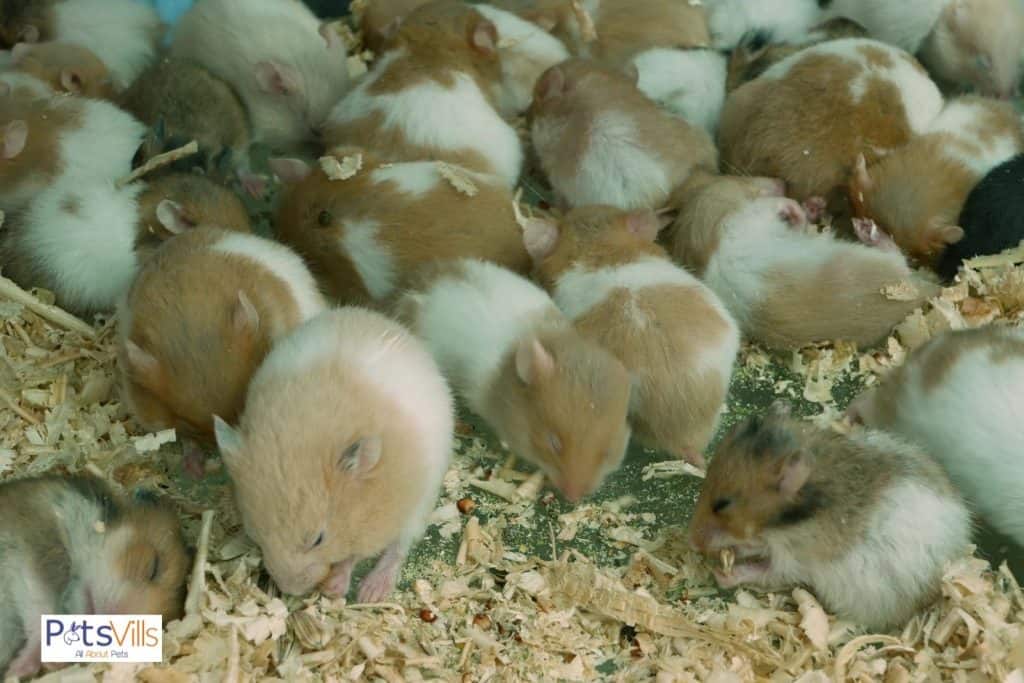
If you have two or more hamsters in a cage, it is possible that overcrowding is the reason behind hair loss, especially if your hamsters fight often.
Wounds from fighting and hair chewing by other hamsters can lead to hair loss around the hindquarters and especially around the tail.
You may need to consider changing the hamster’s living situation if this is the case. If you have mature Syrian hamsters, you should always keep them separated since they are solitary animals.
Aging
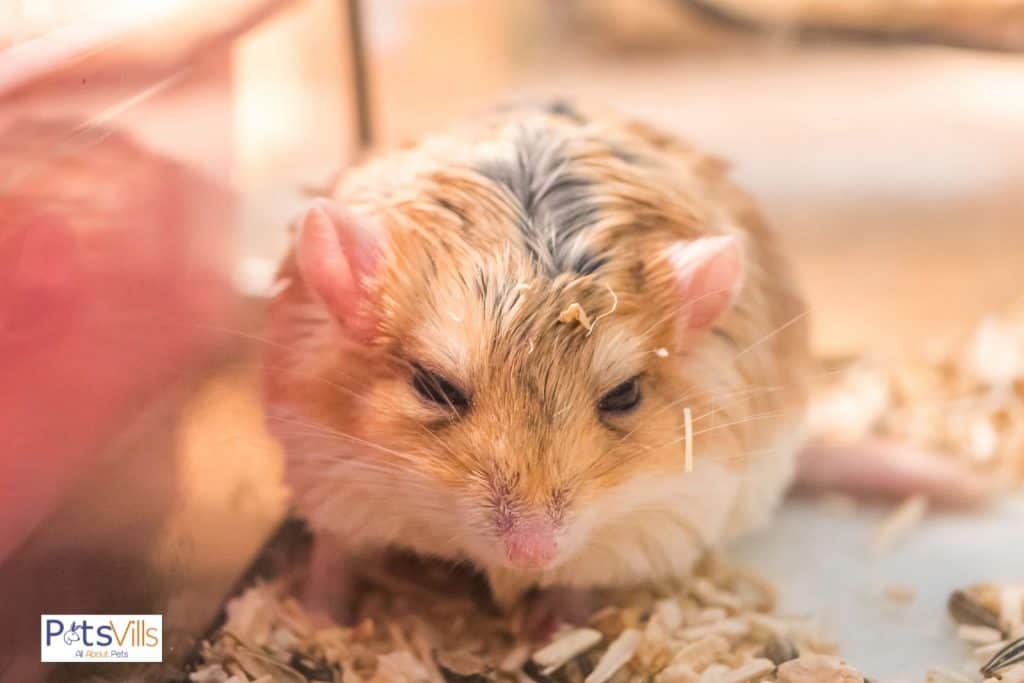
Aging is another common reason for hair loss in hamsters, and it usually occurs on their stomachs, backs, and hind legs.
This happens to male hamsters more often than it does to female hamsters and it is caused by the reduced production of sebum, which is acidic oil and a natural moisturizer that hamsters regularly produce.
Sebum production decreases with age, which is a natural process.
The reason why males are more susceptible to it lies in the fact that sebum production is stimulated by hormones and male hamsters have reduced testosterone levels once they get older, usually when they grow more than a year old.
Sebum forms an acidic layer that protects the skin from bacteria. Its main purpose is to protect the skin and hair in order to prevent them from becoming cracked and dry.
When hair loss occurs due to reduced sebum production the skin becomes vulnerable to bacteria, which can lead to a more serious skin condition –dermatitis.
Environmental Reasons
Environmental causes for fur loss can refer to a leaking bottle of water that soaks the hamster’s bedding, but it is more commonly related to allergies.
An allergic reaction can be caused by the type of food you are giving to your hamster, as well as his bedding which can cause dust allergies.
Watch this video for additional information:
Medical Conditions and Diseases That Cause Fur Loss
In addition to all these reasons, there are a few medical conditions and diseases that lead to fur loss in hamsters.
Protein or Vitamin Deficiency
Your hamster can suffer from hair loss if he has a protein of vitamin deficiency. A diet high in seeds, especially sunflower seeds, often leads to obesity and some kind of nutritional deficiency.
The lack of protein in the hamster’s diet will lead to protein malnutrition. When that happens, the hamster’s body will try to save the small amount of protein it has by limiting the growth of the hairs.
It basically puts the growing hairs into the resting stage called the inter-phase.
Vitamin deficiencies usually include the deficiency of the B vitamins like inositol, folic acid, and B6 biotin. A deficiency in any of the vitamins can lead to weakness, fatigue, and fur loss.
Check: Hamsters Teeth Care
Parasitic or Fungal Infections
Hair loss and different skin diseases in hamsters are often caused by ectoparasites, which is the name for external parasites like ticks, fleas, and mites.
Mites are particularly troublesome because they can often cause mange, a serious and contagious skin condition.
Ringworm is the most common fungal infection that affects hamsters and can lead to scaly and itchy skin that appears in circular patches. These areas can range in size, from a few millimeters to a few centimeters in diameter.
Check out this video:
Kidney Disease
Inflammation of kidneys, or even chronic kidney disease, is another cause of fur loss, although it is not as common as the others we mentioned.
Kidney inflammation can occur in one or in both kidneys and it is usually caused by a bacterial or a viral infection. However, it can also be caused by high blood pressure or disorders related to the immune system.
Hormonal Imbalances
We mentioned hormonal imbalances related to aging, particularly the testosterone levels in older hamsters. However, other hormones can also cause fur loss if there is an imbalance, particularly thyroid gland hormone.
T-Cell Lymphoma
This particular tumor affects the hamster’s skin and can lead to hair loss, as well as skin inflammation.
These symptoms usually appear in sporadic patches. Just like other tumors that affect hamsters, the causes are both genetic and environmental.
Protein or Vitamin Deficiency
Improving your pet’s diet is the only way to treat fur loss caused by protein or vitamin deficiency. Even if your hamster suffers from this problem only occasionally or rarely, a healthy diet is imperative and a great way to prevent fur loss and other health issues.
Adding protein to your hamster’s diet and ensuring that he receives enough nutrients and vitamins through his diet is the first step to treating this problem. You can also supplement the lacking vitamins if necessary.
We will cover the structure of a healthy diet for hamsters in greater detail in our next section.
Allergies
If you suspect that your hamster is scratching a lot and shedding because he has an allergic reaction, take him to the vet to determine the exact cause because different allergies are treated in different ways.
In any case, once you know the culprit behind the allergic reaction, you can make certain changes and keep your furry friend away from that allergen.
For example, if your hamster is allergic to certain foods, you will have to eliminate that food from his diet. If he is allergic to a type of dust, you may need to change the bedding in his cage.
Parasitic Infections
As we have already mentioned, parasites like ticks, fleas, and mites can cause a lot of problems for hamsters. Tick infestation in hamsters is rare unless your pet spends a lot of time indoors or gets in contact with some other infected pet, like a cat or a dog.
However, fleas and mites are not that uncommon. If your hamster has fleas or mites, the first step is to get rid of his bedding and other things in his living environment that may be infected.
After that, clean the cage thoroughly with soap and hot water. If you can afford it, the best thing to do is to get an entirely new cage, bedding, and toys.
Once you are done with cleansing, go to your vet to get the right treatment advice. For example, fleas are often treated with an aerosol spray, as well as a range of flea shampoos.
On the other hand, mites can be a bit harder to get rid of. The first course of action is to kill the mites.
This is done by injection, but it can also be done with creams, lotions and medicated shampoos that contain selenium or medicine called amitraz. Most likely, it will be a combination of some of these options.
If your hamster has already developed mange, use ivermectin to take care of them.
This medication can either be given in the form of injection by your vet or you can use drops directly on your hamster’s skin or give it to him orally.
The medicine is usually administered once a week but your vet will give you the exact information on how to use it and how often.
Fungal Infections
If your hamster has ringworm or any other fungal infection, you will have to bathe him with anti-fungal shampoo.
You can safely use over-the-counter anti-fungal shampoo, much in the same matter as any other shampoo. If shampoo proves ineffective, you may need to use griseofulvin, which is a mild toxin designed to help against ringworm.
In some cases, you may need to shave your hamster’s hair that covers the affected area before you can use the shampoo.
Kidney Disease
Chronic renal failure or kidney disease often leads to fur loss, as well as other symptoms like weight loss, abdominal swelling, and frequent urination, possibly with blood in the urine.
Kidney problems are treated with prescription medications but fluid therapy and nutritional support are also used to help with these conditions.
Antibiotics may also be prescribed if kidney problems are accompanied by bacterial infections, which is often the case.
READ MORE: Can Hamsters Learn Tricks?
How to Treat Fur Loss
The course of action regarding the treatment of fur loss in hamsters largely depends on the underlying medical cause.
Keep in mind that shedding caused by medical reasons should always be brought up to your vet and treated in accordance with his specific suggestions.
How Can I Make Sure My Hamster Has Healthy Fur?
Preventing skin problems and hair loss in hamsters relies upon a healthy diet and a clean living environment.
Adjusting Your Hamster’s Diet
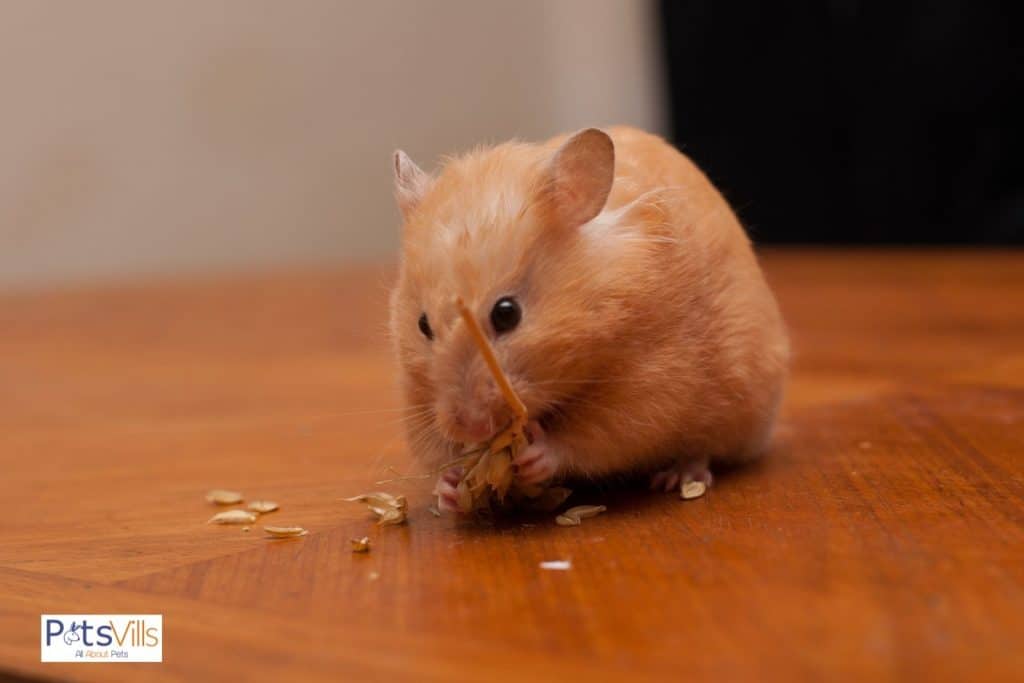
Hamsters need at least 16 percent of their diet to consist of proteins.
To ensure that your pet has enough protein in his diet, include good protein sources like raw and unsalted peanuts, cooked beans, as well as seeds and nuts, with the exception of almond since it contains cyanide and can be fatal for your hamster if he ingests too much of it.
Keep in mind that excess protein can also cause health issues, so try to stay in that healthy 16-percent zone. Commercial hamster foods clearly list the amount of protein per serving so you can easily calculate how much to feed him.
While seeds are a good source of protein and should be a part of your hamster’s diet, you need to limit his seed consumption, especially sunflower seeds.
A diet high in seeds can lead to vitamin deficiency. You can substitute sunflower seeds with corn, dried peas or fruit, and barley.
Iron is also an important part of your hamster’s diet and if adding protein doesn’t help with his hair loss, the reason might be the lack of iron.
Hamsters should consume over 10 mg of iron per kilogram of their body weight on a daily basis. Good iron sources include hard-boiled eggs, iron-rich cereals, and dried fruits.
Add Vitamins and Supplement
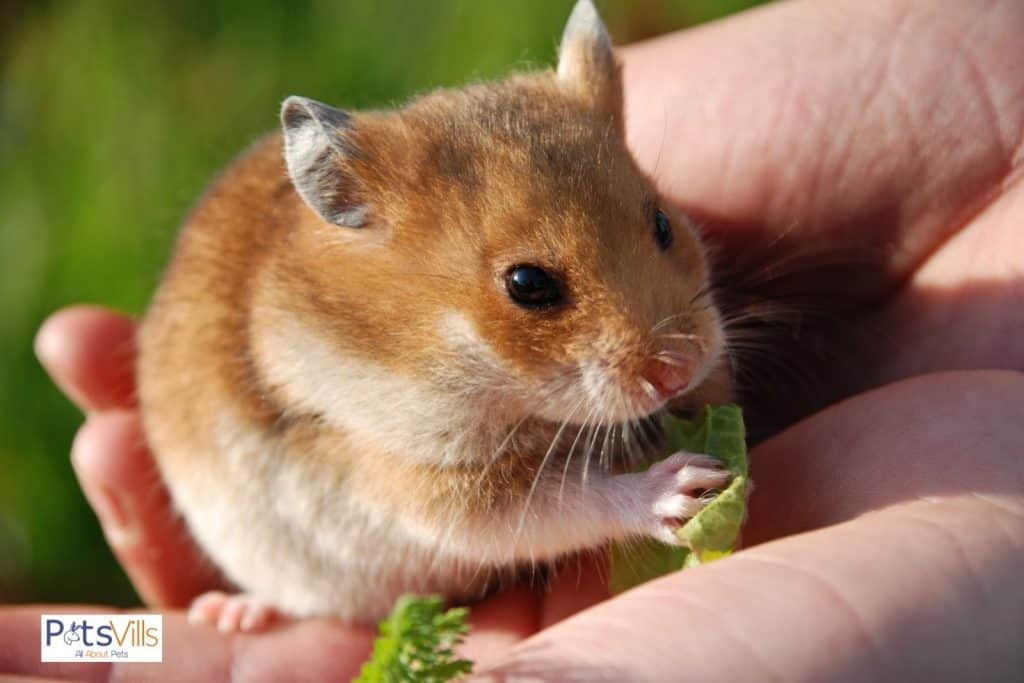
Vitamin deficiency is one of the most common reasons for fur loss in hamsters. A balanced diet may take care of that but if it doesn’t you may need to supplement your hamster’s vitamin intake.
Water-soluble vitamins can be given to hamsters in the form of multivitamin drops. You just add the drops to his water and that’s it.
However, the frequency of this depends on the type of vitamin drops, so follow the manufacturer’s directions or ask your vet for advice on how to properly dose vitamin drops in your hamster’s diet.
A daily drop of cod liver oil in your dog’s water or meal can help as well. You can also give your furry friend a yeast tablet once a week because it can prevent hair loss, especially if you have a senior hamster.
Keep His Cage Clean
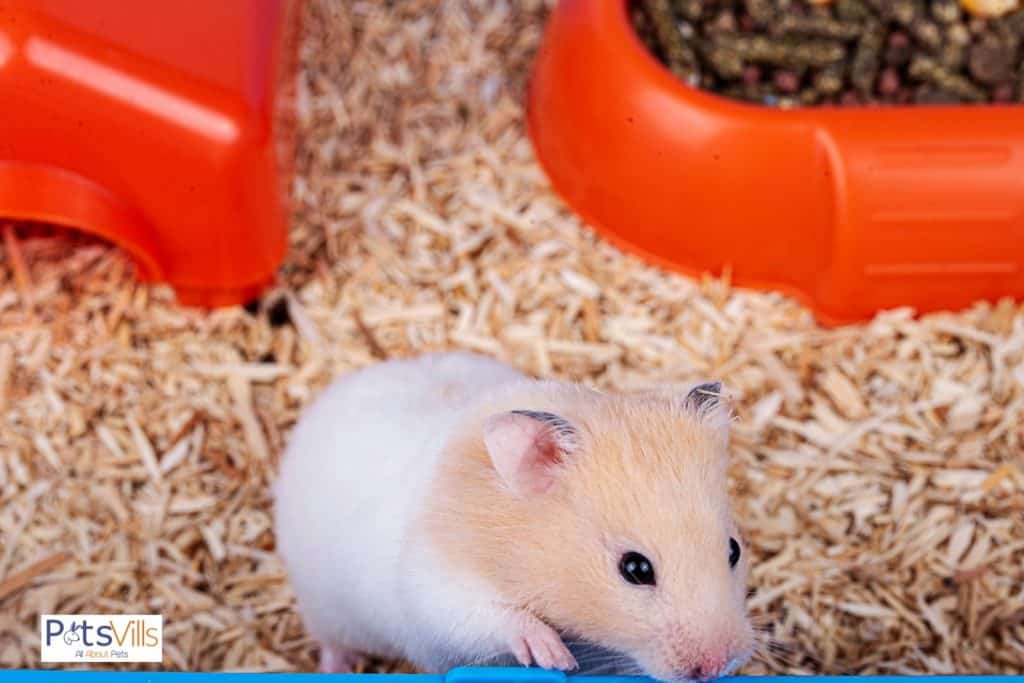
Keeping your pet’s cage clean is the best way to prevent parasitic infections. It is particularly important to regularly change his bedding and clean his toys and other belongings.
If you want to be absolutely sure that your hamster has the best chance to stay free of parasites, make sure you’re spot cleaning their cage once a week.
READ MORE: Can Hamsters Burp?
Do You Need to Groom Your Hamster?
Hamsters are self-grooming animals, which is why they are one of the most desirable pets. They are low-maintenance but some breeds may require a bit of grooming to keep their fur healthy, especially long-haired breeds like Syrian hamsters.
A brush is enough for short-haired breeds, but if you have a Syrian hamster it may be better to get a comb for brushing his coat. Keep some treats near in case that your hamster gets nervous when you groom him.
You don’t have to brush your hamster’s hair often but try to do it once a week, or twice a week if you have a Syrian hamster.
You should also do it any time you notice tangles or knots in his fur. Long-haired breeds may even require occasional hair trimming, especially if he won’t let you brush his coat.
A Hamster Grooming Themselves:
Give Your Hamster Sand Baths
Since hamsters are able to groom themselves, you don’t need to bathe them in water. However, you can let them have sand baths.
Sand baths involve a small dish with a special send in which your hamster can roll around. This will help them get rid of any debris like feces that may be caught up in their fur.
FAQs:
Why has my hamster got a bald patch?

Bald spots on your hamster could be due to your hamster rubbing themselves on rough objects such as a toy or bedding. It could also indicate abrasive bedding or an allergic reaction. A leaking water bottle can also cause hair loss. If you are concerned it is recommended to take your hamster to the vets.
Do hamsters molt?
Yes, hamsters molt/shed. They will molt more during the hotter times of years.
Why is my hamster biting himself?
If your hamster is biting itself it could indicate a health issue. Some health issues could be are mites, fleas, or skin irritation. Hamsters will sometimes bite themselves when they are cleaning their fur.


References
- “Pet Hamster Breed Information | PetSmart.” 2021. Petsmart.com. 2021. https://www.petsmart.com/learning-center/small-pet-care/so-you-want-a-hamster/A0010.html.
- PetMD Editorial. 2010a. “Hair Loss in Hamsters.” Petmd.com. PetMD. July 7, 2010. https://www.petmd.com/exotic/conditions/skin/c_ex_hm_alopecia.
- ———. 2010b. “Inflammation of the Kidneys in Hamsters.” Petmd.com. PetMD. July 9, 2010. https://www.petmd.com/exotic/conditions/urinary/c_ex_hm_nephritis.
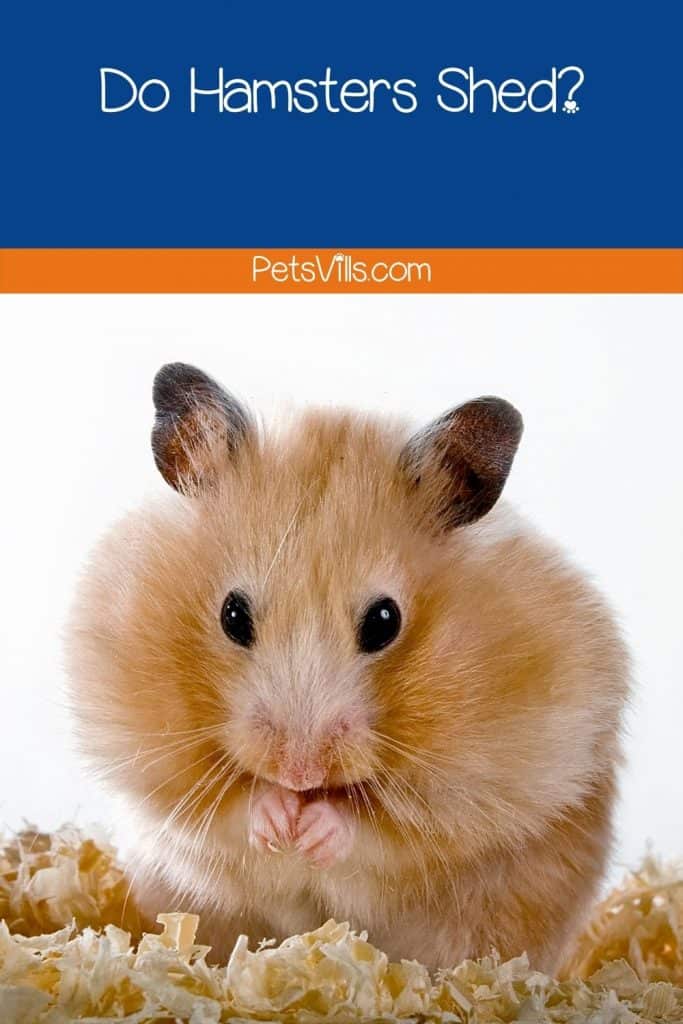
Did you ever visit a vet for your hamster’s hair loss problem? Let us know in the comments below!
Alina Hartley is a small-town girl with a ginormous love of bearded dragons. It all started with Winchester, a baby bearded who was abandoned at the shelter by his former owners because of a birth defect that caused one front leg to be shorter than the other. Alina originally went to the shelter looking for a guinea pig, but one look at Winchester and it was love at first sight. From that day on, Alina has dedicated her life to learning everything she can about bearded dragons. She loves helping new beardie parents start their incredible journey with these magnificent reptiles.
Follow her on:
LINKEDIN
TWITTER.
Read her latest articles HERE
Learn more about her HERE.


